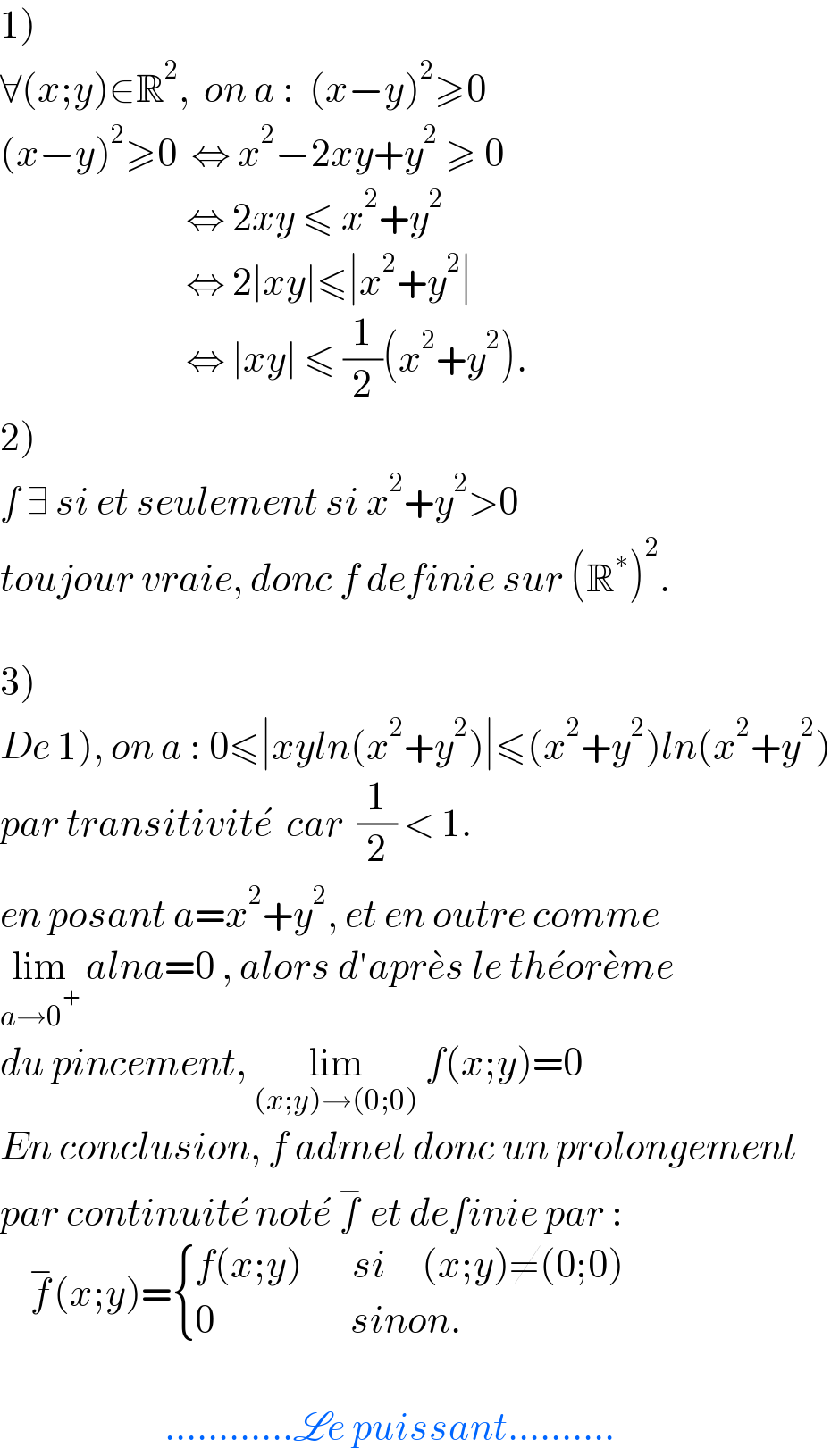
Question Number 171725 by SANOGO last updated on 20/Jun/22

Answered by puissant last updated on 20/Jun/22

$$\left.\mathrm{1}\right) \\ $$$$\forall\left({x};{y}\right)\in\mathbb{R}^{\mathrm{2}} ,\:\:{on}\:{a}\::\:\:\left({x}−{y}\right)^{\mathrm{2}} \geqslant\mathrm{0} \\ $$$$\left({x}−{y}\right)^{\mathrm{2}} \geqslant\mathrm{0}\:\:\Leftrightarrow\:{x}^{\mathrm{2}} −\mathrm{2}{xy}+{y}^{\mathrm{2}} \:\geqslant\:\mathrm{0} \\ $$$$\:\:\:\:\:\:\:\:\:\:\:\:\:\:\:\:\:\:\:\:\:\:\:\:\:\:\Leftrightarrow\:\mathrm{2}{xy}\:\leqslant\:{x}^{\mathrm{2}} +{y}^{\mathrm{2}} \\ $$$$\:\:\:\:\:\:\:\:\:\:\:\:\:\:\:\:\:\:\:\:\:\:\:\:\:\:\Leftrightarrow\:\mathrm{2}\mid{xy}\mid\leqslant\mid{x}^{\mathrm{2}} +{y}^{\mathrm{2}} \mid \\ $$$$\:\:\:\:\:\:\:\:\:\:\:\:\:\:\:\:\:\:\:\:\:\:\:\:\:\:\Leftrightarrow\:\mid{xy}\mid\:\leqslant\:\frac{\mathrm{1}}{\mathrm{2}}\left({x}^{\mathrm{2}} +{y}^{\mathrm{2}} \right). \\ $$$$\left.\mathrm{2}\right) \\ $$$${f}\:\exists\:{si}\:{et}\:{seulement}\:{si}\:{x}^{\mathrm{2}} +{y}^{\mathrm{2}} >\mathrm{0} \\ $$$${toujour}\:{vraie},\:{donc}\:{f}\:{definie}\:{sur}\:\left(\mathbb{R}^{\ast} \right)^{\mathrm{2}} . \\ $$$$ \\ $$$$\left.\mathrm{3}\right) \\ $$$$\left.{De}\:\mathrm{1}\right),\:{on}\:{a}\::\:\mathrm{0}\leqslant\mid{xyln}\left({x}^{\mathrm{2}} +{y}^{\mathrm{2}} \right)\mid\leqslant\left({x}^{\mathrm{2}} +{y}^{\mathrm{2}} \right){ln}\left({x}^{\mathrm{2}} +{y}^{\mathrm{2}} \right) \\ $$$${par}\:{transitivit}\acute {{e}}\:\:{car}\:\:\frac{\mathrm{1}}{\mathrm{2}}\:<\:\mathrm{1}. \\ $$$${en}\:{posant}\:{a}={x}^{\mathrm{2}} +{y}^{\mathrm{2}} ,\:{et}\:{en}\:{outre}\:{comme} \\ $$$$\underset{{a}\rightarrow\mathrm{0}^{+} } {\mathrm{lim}}\:{alna}=\mathrm{0}\:,\:{alors}\:{d}'{apr}\grave {{e}s}\:{le}\:{th}\acute {{e}or}\grave {{e}me} \\ $$$${du}\:{pincement},\:\underset{\left({x};{y}\right)\rightarrow\left(\mathrm{0};\mathrm{0}\right)} {\mathrm{lim}}\:{f}\left({x};{y}\right)=\mathrm{0} \\ $$$${En}\:{conclusion},\:{f}\:{admet}\:{donc}\:{un}\:{prolongement} \\ $$$${par}\:{continuit}\acute {{e}}\:{not}\acute {{e}}\:\overset{−} {{f}}\:{et}\:{definie}\:{par}\:: \\ $$$$\:\:\:\:\overset{−} {{f}}\left({x};{y}\right)=\begin{cases}{{f}\left({x};{y}\right)\:\:\:\:\:\:\:{si}\:\:\:\:\:\left({x};{y}\right)\neq\left(\mathrm{0};\mathrm{0}\right)}\\{\mathrm{0}\:\:\:\:\:\:\:\:\:\:\:\:\:\:\:\:\:\:\:{sinon}.}\end{cases} \\ $$$$ \\ $$$$\:\:\:\:\:\:\:\:\:\:\:\:\:\:\:\:\:\:\:\:\:\:\:............\mathscr{L}{e}\:{puissant}.......... \\ $$
Commented by SANOGO last updated on 20/Jun/22

$${merci}\:{bien} \\ $$
